More of My Beginnings As a Craftsman, Teacher and Educator
Partly in answer to the “How to get started in woodworking?” question
I remember hearing a more mature person ask a Woodcraft store (USA woodworking franchise chain) manager this question when I lived and worked in the US. The manager’s eyes shone brightly in response and he quickly whisked the customer off to the far side of the store and with a wide sweep of his arm said, “It’s all here!” Machines arrayed like cars in a new car showroom glinted beckoningly and I knew that the man yet to be converted was about to part with a chunk of his pension. Outfeed tables concertinaed in storage were whiplashed into position and bandsaw doors were popped open with the quick twist of two knobs. Laser crosshairs aligned saw blades to the task of crosscutting and delivery dates were arranged before you could say Norm Abrams. There was no questioning beyond the opening one and hand tools were never mentioned. It was an interesting phenomena to me as I prolonged my staring at the many books on display so I could listen in all the more to the words of the salesman. Evolution and the survival of the fittest has of course been proven to be a fallacy in that it’s been proven that those best able to adapt survive in an uncertain world. The chain stores do of course provide some level of service but the bigger they get the less likely they are to adapt and do going into such stores quickly becomes what Americans refer to as, “The same ol’ same ol’.” Should I have interjected something at that point? Perhaps offered a more balanced approach like start out with this or that machine and add in some classes and a few hand tools? I knew better. I was a complete unknown in the USA back there in 1988. My philosophy on hand woodworking was often mostly greeted with bemused tolerance and interest coupled with unbelief. I learned to kerb my enthusiasm a little and I picked my battles more cautiously. I knew that for me to make any difference I would need to prove the reality of hand work by using methods in front of my audience that obviated the truth that hand tools were far more interesting than people knew. It could not be slight-of-hand demonstrations but a real message of slowed-down woodworking everyone could really see, understand and then keep pace with and learn to master at whatever pace they wanted. Most of the audiences I engaged with saw methods most of them had never actually seen live before. This fact alone amazed me because I had been so used to it in my daily life growing into my craft. It was the simplicity of the message backed by reality showing. Just as all of my work on the videos we make are indeed completely unscripted, so it was back then when I decided to go to woodworking and craft shows where I would most often be the only crafting artisan teaching from a background of actually earning his living from real woodworking up against the empire of machine makers.
Back then I had a 10 foot by 10 foot booth only. My surrounding neighbours front back and sides had 40 foot by 40 foot booths. Dwarfed in the arena of giants seemed at first to be very negative but, as with many things, a minuscule presence often stands out in a crowd. With my single-sided 2 foot by 5 foot workbench and two dozen hand tools in a small toolbox I felt just right. Some people outright laughed at me whereas others chuckled, giggled, smirked or were outright rude. At least that’s what happened at first, but then my opportunity came. At 11am my first demo was scheduled and I had 20 minutes to wow my tiny audience with the reality of an unalloyed alternative but would they listen to this small voice in the wilderness. 20 seats were squared across the front of my workbench and only six people came to sit. I had already decided I was going to demo whether anyone came or not. Ten tools from the two dozen I had were laid out on my benchtop in front of me and I picked them up one by one. I was very much the fish out of water. A foreigner, a hand tool enthusiast and an unknown quantity to all. But I was in Tulsa, Oklahoma and though a long way from the comfort zones of my native England, Tulsa was one of the friendliest towns I’ve ever been in. The Okies welcomed me and made me so welcome and even if half the words I used were misunderstood the action at the bench was not. I picked up a piece of wood and split it along its length in two seconds. In a few minutes I made a spatula with a tenon saw, a mallet, a spokeshave and a brace and bit. Six people stayed in their seat, but 20 more gathered in the aisles either side. To be honest they seemed to be quite mesmerised and when I was done they did me the honour of clapping and cheering loudly. More people joined the happy throng and I asked questions and made statements like, “How many of you know that with 3 joints and 10 hand tools you can make just about anything from wood?” No reply but a few smiles. I then made a 2 minute dovetail joint with twin dovetails that just came out too perfect for words. I passed it around, explained its functionality and then explained the use of the knifewall. That was the first time I named the knife cut across the grain of the wood a knifewall. I didn’t invent the method but I did give it that name because I felt refining it and defining it created its worth in words people could understand. I used only four hand tools and a pencil for the dovetail demo and by the time I was done all the seats were filled and so too the aisles. I continued demoing and for the rest of the day all of my demos were filled and enthusiastically received. The show organisers doubled and then tripled the seating and gave me a bigger space. As the years passed we need large TV screens and 200 seats. The aisles too filled and non one could pass. My fears and doubts were over. That was my first experience of public demoing of any scale and imagine how it feels today to be able to reach many hundreds of thousand every month who are having their lives changed by a handful of people centred right hear in the beautiful Vale of the White Horse in Oxfordshire.
I made many wonderful friends at the woodworking shows through the decades I lived, worked and traveled in the US. Those early days gave me insights into the hearts of people searching for a worthwhile way of working with their hands that took them off the conveyor belt and into a proactive, sustainable way of working that truly fostered wellbeing. Today I love my outreach all the more because we still stand out amongst the giants. We are small a compact but we are truly a team of people who care so passionately about woodworking, woodworkers, the art and craft of work and providing an alternative reality people feel all the more able to explain away to others. You have become my voice, you are proof that what I and we do works. I come to work with a sense of real purpose and I am so glad retirement is just a distant concept I never think of.


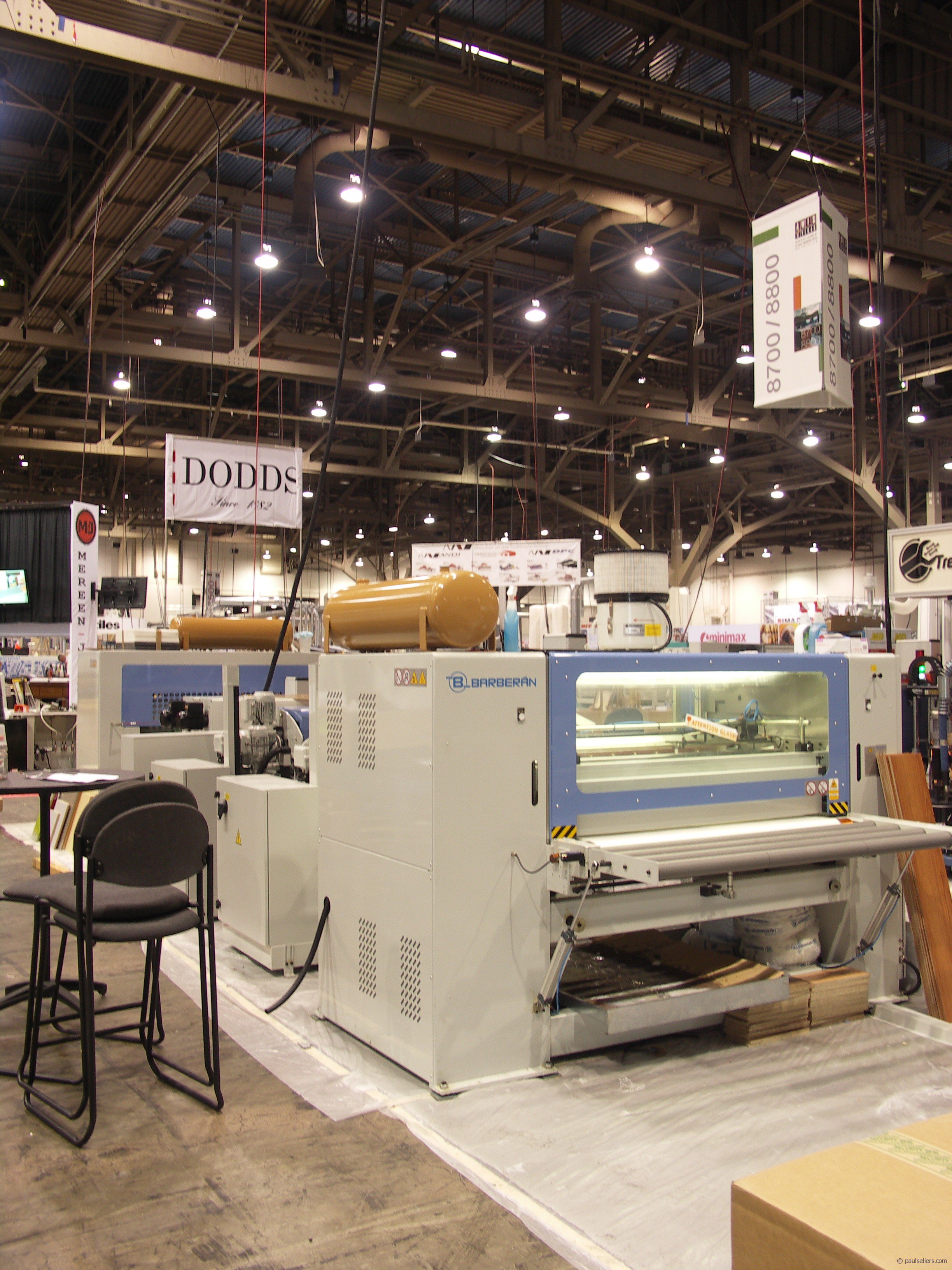
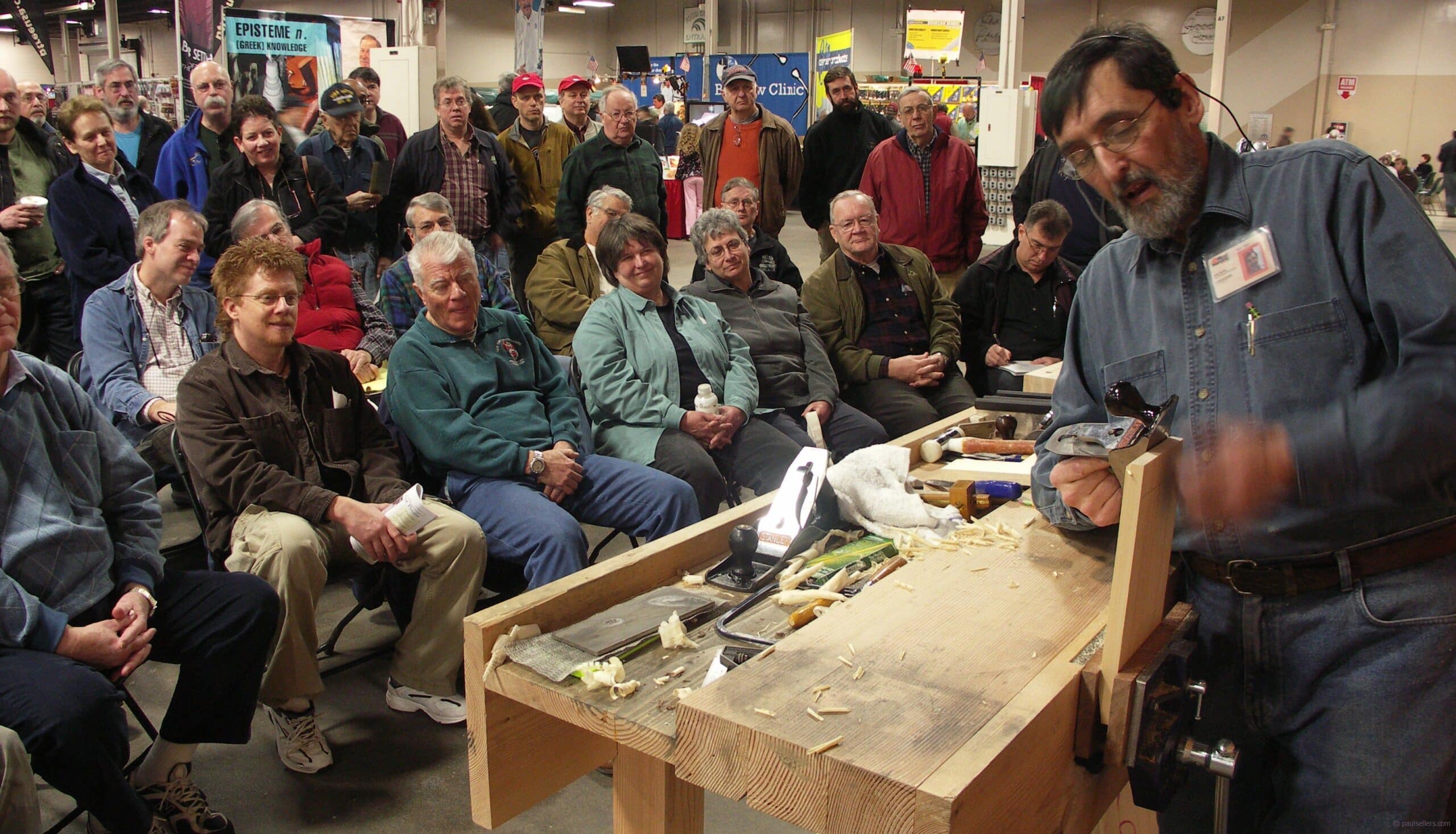
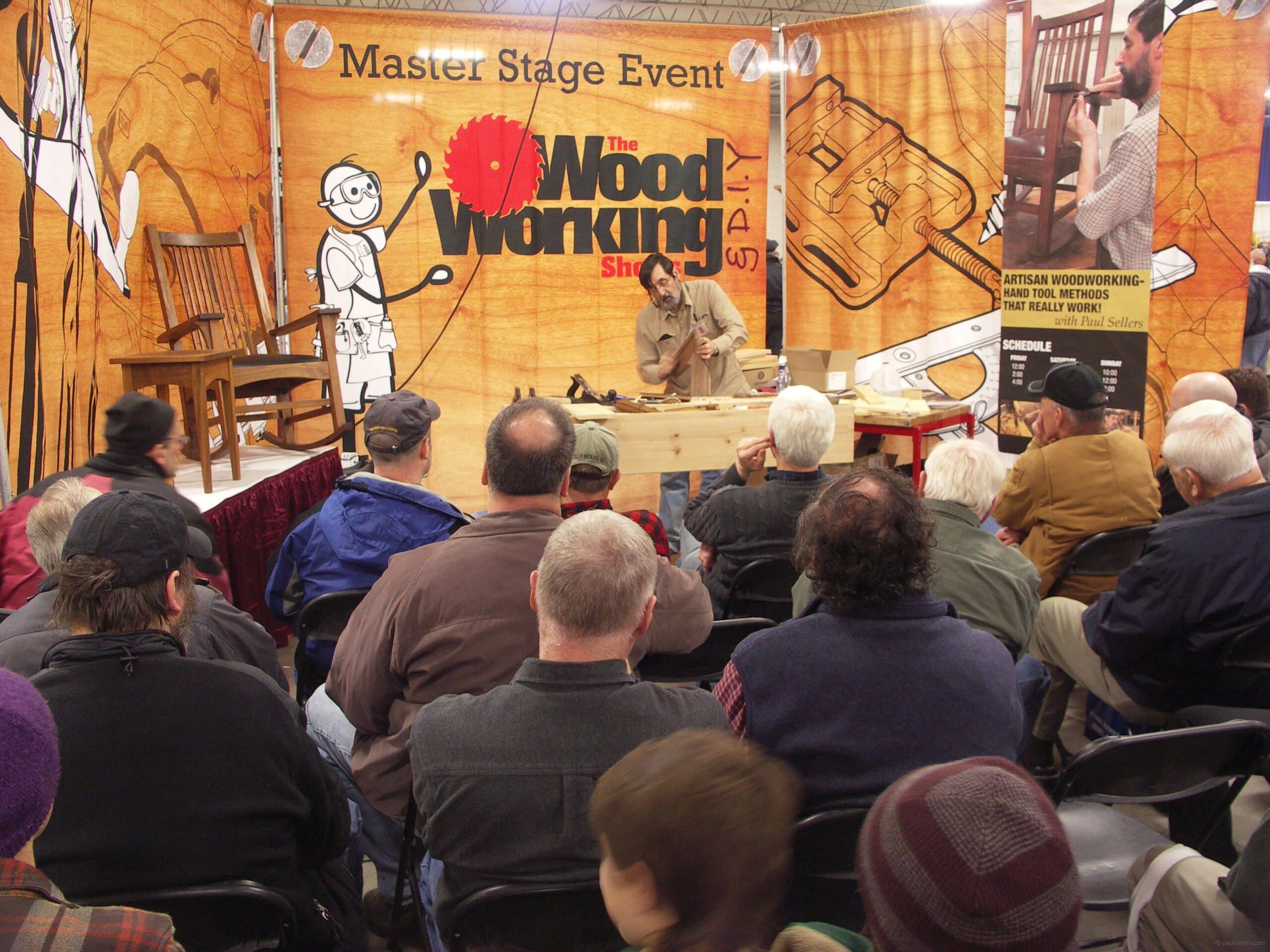
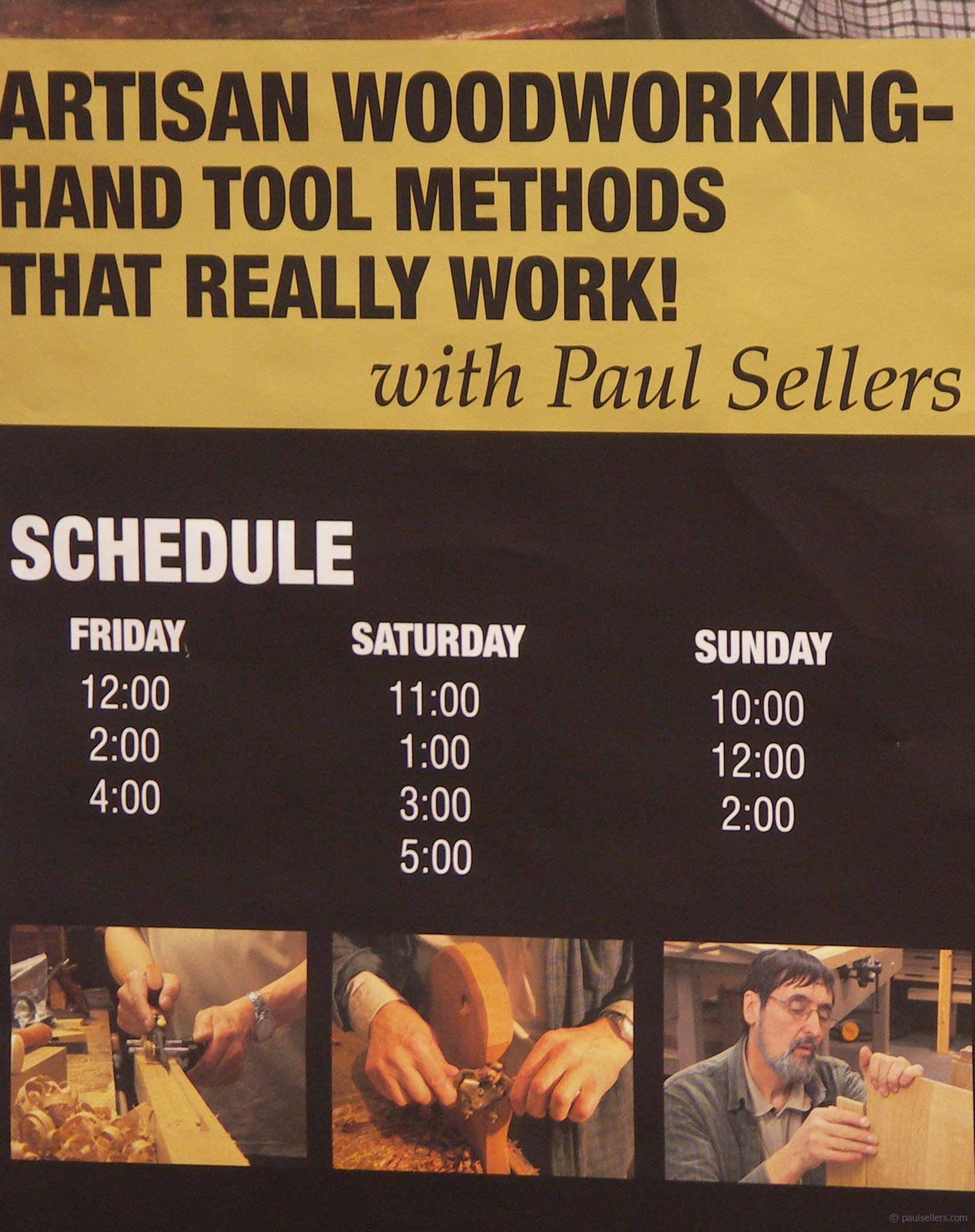
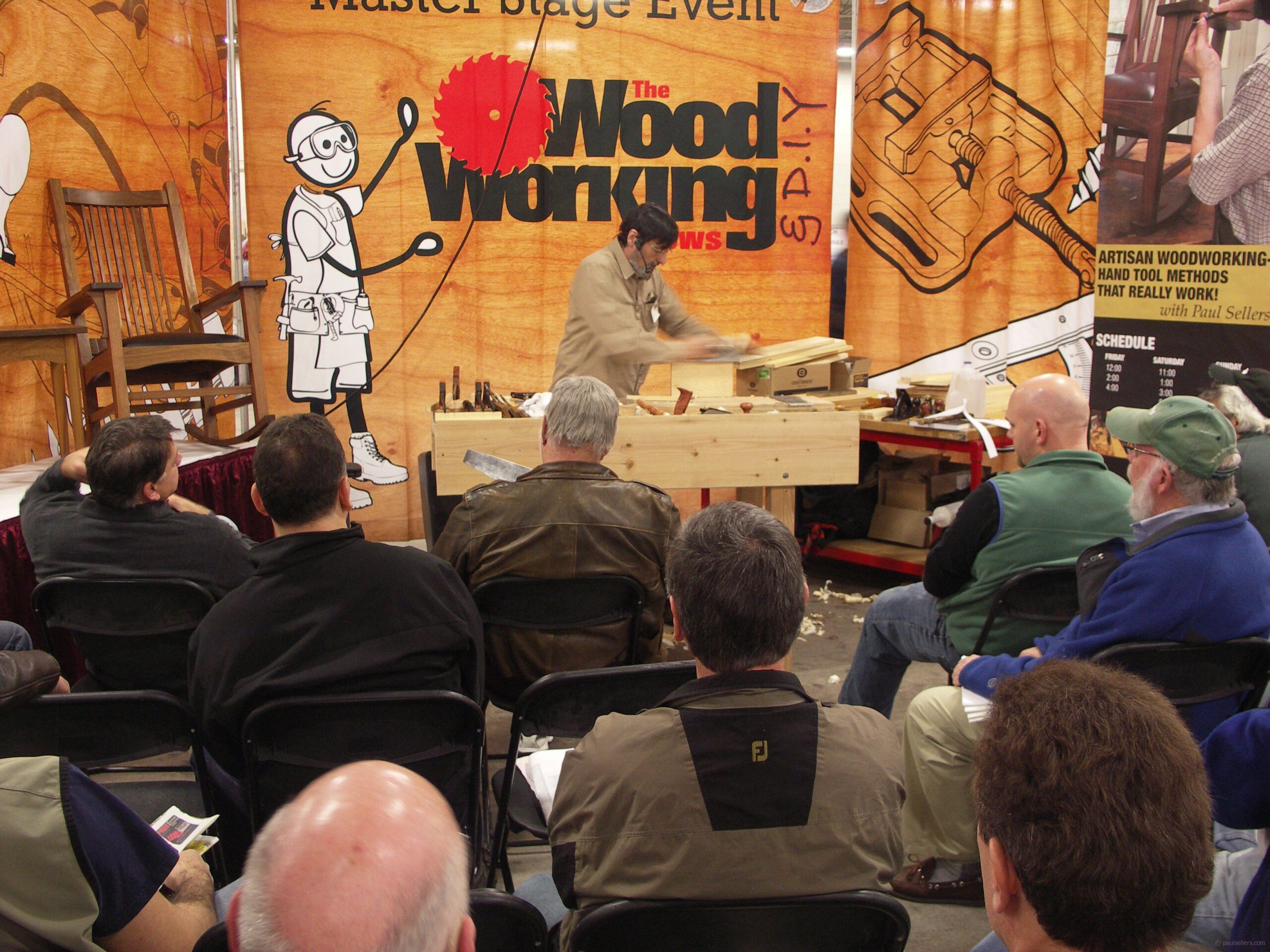
I can remember a just a few years back, before you had the website or the YouTube channel; seeing people’s short videos posted from these trade shows. Even though they were only fragments of demos, they were great at breaking me out of the assumptions I’d held – rip sawing upright in the face vise was something I’d never thought of. If you don’t mind, what was the “product” you were promoting at the time? Was it classes or DVDs? Something else?
Hi Paul,
I gave up going to most woodworking shows years ago. They should really be called wood machining shows. The last show I attended at Alexandra Palace there were no hand woodworkers obvious. Most demo’s seem to be either woodturning, routing or some gimic being pushed.
There is one show I still do attend occasionally at Kempton. This is only because it is close, entry is free and you can occasionally pick up a bargain hand tool or other consumable.
I would dearly love to see a return to hand tool demonstrations but can only imagine that there are a lack of people with the requisite skills or there is not enough profit to be made. Unlike power tools once you own a hand tool you rarely need to spend anything other than time for maintainance.
Paul,
Thank you for your excellent work in reacquainting humanity with fundamental hand skills. I grew up watching public television woodworking shows and believed “woodworking” to be only about acquiring the skills to use a table saw or bandsaw or router in a masterful way. Roy Underhill’s “The Woodwright’s Shop” was the only hand tool show I recall seeing growing up; and in the sea of other, power tool-based shows, I always had the impression that he was simply demonstrating techniques of the past for historical academic purposes. In recent years (i.e. less than 2 years) I have become fascinated with the idea of woodworking with hand tools. If there is anything to be said for modern technology it is that venues like YouTube and internet search engines have introduced me–and no doubt hundreds of thousands of others–to the concept of woodworking with hand tools alone as a doable thing. (The hardest part of transitioning from power tools to hand tools is knowing the high potential for error early on as a result of not sharpening and holding and using tools properly; but you have simplified and clarified this in very easy to understand terms, which I much appreciate.) I have gotten to learn from you, Phil Lowe, and others through the internet. It is inspiring. You have made me a believer. Thank you.
Likewise I grew up watching Norm on the local PBS station and largely ignored that guy that was on before him that was always bleeding all over the wood and never understood why my grandfather liked to watch him. That could have been me in the Woodcraft store being shown to the rows of expensive power tools, for we know not what we do.
Without people like Paul and the communication medium that we enjoy today I’d still consider hand tools dying relics of our past.
Good summary of Paul Sellers ‘way’?
I call it swimming against the tide.
IMHO you won Paul.
Paul
While at a woodworking show in San Antonio I watched as you cut a dovetail joint in a few minutes al the while just chatting casually about the process and the craft. I was converted from the Church of Norm to the School of Paul.
I took a couple of classes while you were in Elm Mott. Thank you for the inspiration and reinvigorating the craft that has gone dormant in my soul.
I am a technologist by trade (video, Internet, etc.) but have always stressed the KISS principle in my vocation. Thank you for letting me see that simple applies to my avocation as well.
Cheers!
Todd ONeill
Frequently, in the various magazines I subscribe to, they print pictures of workshops people have sent in. They look like factories!! Really, small factories!! The machinery and dust collection setups are astounding.
But I understand the draw. Machinery can obviate the time and effort it takes to build skills. And since many in the craft are older retired guys (gals), time is a premium.
Good to know Hooeywood (Hollywood) hasn’t gotten their grubby mitts on you. I can just imagine the product placement in the movie version of your life, but hey, an interesting story and life nonetheless. I appreciate what you do. I still use my table saw probably more than I like to admit, but you definitely gave me and many others the gift of knowing it’s not necessary most of the time. My chisels and planes stay close at hand and get used daily because of the things I learned watching you over a tiny wifi signal so those machines that send us the signals come in pretty handy..
“First they ignore you, then they laugh at you, then they fight you, then you win.”
–Mahatma Gandhi
Mr. Sellers, many thanks for your vision and generosity. I’m very glad to meet you.
–humanic
Hi Paul,
I can completely relate to this posting. I had wanted to get into wood working but had postponed for about 10-15 years because of limited living space. I’m in my mid-40s and grew up watching the shows This Old House and New Yankee Workshop. There is very little hand tool use on these shows. I loved also watching Roy Underhill’s show with the handtool work. However, I misinterpreted Roy’s show. I assumed it was more of a historical explanation on how things were done rather than it was still a valid way of doing it. I was in my early 20s and I just didn’t know any better and the internet as we know it didn’t exist in the early 1990s. Plus the world around me was all power tools. I can easily see how when someone walks into a store asking to get into woodworking he is shown power tools.
Where I got lucky was that after I remodeled my garage in the home I had just bought, I didn’t have enough money to buy the tools and my biggest worry was dust collection and I wanted to research that quite carefully. As a chemist, I was already used stringent air control to keep me safe. In addition into looking into air control of dust, I wanted to research workbenches. I think power tool use or hand tool use both want a good workbench.
It was more by chance than anything else I came across Chris Schwartz’s book on workbenches. I loved what I saw. As such, I read more that he wrote and a lot of that is on hand tools. It all made sense when I read it. I then found you on YouTube. It all made sense. I got the skill (not a machine) which is what I really wanted. I didn’t have as much of 2-5 micron dust issue (which I think is much more serious of a problem than folks want to admit to or industry wants to tell us). It also cost less and took up less room.
It was immediately apparent from the onset of my decision to go with hand tools everyone thought I was crazy – it’s slow, you can’t do as good work, etc, etc. Well, yes it will be slower on the big cuts but I’m not in a rush as it is a HOBBY for me. As time goes on my skill will get better so the stuff I make will be nicer.
I’m quite happy to have moved into hand tool work. My dad who was against this, is starting to think I am talented based on the first few things I have done. I don’t think it is talent. Rather I think it is much easier than most people realize.
I can completely understand why you faced what seemed an uphill battle over folks minds initially. That is, until they saw it is much simpler than we have been lead to believe to do hand tool work. I think the power tool industry has done a lot to perpetuate this myth as well as it is in their interest for you to buy pricy power tool not inexpensive hand tools.
Your videos have helped a great deal. I can’t wait till I take a class this fall at a local place and spend two days learning how to make dovetails by hand. From there, I plan to take a one week class a year (my vacation) on hand tool woodworking. It won’t take long at all before I have the skills to make furniture to fill my home that has crisp clean joints and tight tolerances.
Hi Joe,
Great comment (or great post I should to say). Very illustrative and also hillarious your statement: “I can easily see how when someone walks into a store asking to get into woodworking he is shown power tools”…
I was following very close your own steps but instead to get the Chris Schwartz’s book I read a the classical title “Workbenches” by Scott Landis. There was an small kind of revelation: I found a picture (http://67.media.tumblr.com/99935bd8e2a0ed7579b379a1cd14287e/tumblr_nyywt87kaK1ul1t3eo1_1280.jpg) of Toshio Odate into his workshop. Something sparked into my head, this image changed radically my concept of workshop. The minimalism and efficience go together to create an space where the center is the craftsman itself and not a shiny branded saw table nor a pristine workbench. The human being as a center of the craft. Then I meet Paul Sellers and all changed, forever.
You know, I love a lot the Paul Sellers’s classical teaching method, but not only for himself, it’s also by his followers who share a, for now, very strange intuition about this wonderful craft. They (or us) are a legion of people who are not mainly professionals. We call ourselves hobbysts or amateurs but I think we are the seed of a new movement, sharing constantly knowledge and experiences without borders through the net, changing slowly but firmly the *status quo*.
In 2001, Bill Gates, CEO of Microsoft said: “We think of Linux as a competitor in the student and hobbyst market”. Today, fifteen years later the next versions of Windows will add tools to interchange data with Linux filesystem. It seems like the “hobbyst market” of open sourcers is near to win. Just now we are interchanging our thoughts using internet because the same hobbyst movement dreamed a new order where the human being is the pivotal motive and want made the interchange of information be free for everybody.
We can go with the Nature or against the Nature and hand work represents a great respect for the planet itself and also for our spirit. We are avid of more humanity into our own actions. The world is changing and I hope it will be more humanic…
So, anyway, thanks for share your intimate comment.
–humanic
PS. Please, be indulgent with my poor english.
Norm Abram is a class guy who taught me a lot. I love watching you work in a different way than Norm but no more or less important. I hope your comment about Norm was more illustrative than implied criticism about different techniques. I appreciate your passion and teaching and sincerely believe there is room for more than one woodworking technique. In the end, the gratification derived from a well done, completed woodworking project is similar regardless of the tools or techniques utilized. Keep up the good work in teaching us alternative ways of completing woodworking projects. Some of us use both methods – mechanized and hand tools – to do what we love. Thanks again for your teachings and insight.
Rick
Interesting i went into a big chain woodworking store for help with a hand scraper the first cleark didnt know what i was talkng about. The oldest fellow there had never sharpened one just”wiped it ff and put it away”. ? While i havnt quite got the hang of it yet you have shown me what ro do
I also followed Norm and Roy and have met both in person great men working wood 2 different ways. I for years use to go to the Woodworking show in Atlanta but it just got to be more a power tool show as opposed to hand tools and haven’t been to one in about 12 years. I am not sure if you ever worked the Atlanta show and if you did I obviously missed you and I certainly would be sitting in the front row for sure.
Please keep doing what you are doing and I really appreciate what you have taught me over the past 3 years or so. I do frequent another woodworking forum daily along with yours. I don’t subscribe to any magazines anymore and do not watch the TV shows unless it is Roy Underhill which for what ever reason we do not get all the time.
Steve
I did go to the Atlanta show too. It’s funny but I have never watched Norm but I did once see 5 minutes of Roy in YT video years ago. So they have never been influential in my work save to counter misinformation and try to drag people of the conveyor belt whenever possible. TV has never been a part of anything much in my life and when I lived in the USA I never watched it once in 22 years because I liked living things more I suppose.
Thank you for your efforts and love of the craft. Without it, where would we be?
I am very grateful Paul for your proving that handtool woodworking is doable and does not require a genius.
My handtool journey had a slow start, I read the wrong handtool books where tuning your tools would require a metalworking shop and skills so I almost went for the machines. (and thats a word of caution for my fellow woodworkers)
I almost gave up. Luckily I came across a short video of yours…
Thanks Paul.
Hi Mr. Sellers,
I’m struggling to get going for myself in furniture making. I don’t have a lot of money to spend on even basic hand tools and I’d like to be able to make some projects for sale just to get started in financing some better tools for my own personal projects. Do you have any recommendations for small projects that sell well for this purpose?
That could be a hard thing to pin down. I know I’m just starting to go through Paul’s book and I’m making a bunch of spatulas and spoons. I’m sure around my area they would sell but I’m personally not doing this for the money so everyone I know is getting new utensils even if they don’t know it yet. I’m more into learning the skills to be able to build anything I want or desire to build. The more I learn the nicer the piece I can create. Those first few projects really don’t take many tools and are pretty fun and rewarding to complete.
I think that maybe you have this the wrong way around. You want to earn money from something you are not equipped for? The thing is this. I have learned enough about the USA and Europe to realise that it is commonly thought that earning money from making comes before learning and mastering and equipping. My thought is not to earn but make without selling that way you establish skills, knowledge and understanding. Make for friends and relatives and get the tools one by one as and when you can afford them. With about ten hand tools most things can be made. You don’t at all need the best tools. secondhand ones will cast a fraction of new but some one ones are indeed cheap. A set of chisels can be had for under $20 or £20 coping saw for 5, a plane for around 20 and so on. Just get them as you can afford.
My great grandfather was a carpenter who specialized in fine homes and churches. He grew up ” in the trade” learning from his father, a German born carpenter, whose home still stands in York, PA. I am blessed to own one of my great grandfather’s furniture pieces, as well as one of his German planes and a framing square. I can also visit a church he remodeled In 1890.
Perhaps the fact that I was aware of my great grandfather’s legacy at a very early age influenced me to sneak my dad’s prized Disston out and saw out rabbit traps when I was 8 years old. When Underhill’s series made it to our TV, I thought I was in heaven. For years I was not aware of anyone else who watched the show. Some 40 years ago I began collecting historic woodworking tools. Although I occasionally use my ancient table saw and newer sliding chop saw, I draw immense pleasure in using my hand tools. I keep my Stanley #4 within easy reach, with the #5 close by. If I need to I can call on one of my 30 or so wood bodies, using my #45 and its 40 or so cutters in reserve. I have all the tools I want….and much more than I need.
When I discovered the Paul Sellers videos on YouTube, I was thrilled. I quickly learned some ways to improve my techniques. My discovery came at the most opportune time. At a recent visit to my sister’s new home, she asked me to look at an old table. I immediately recognized it as a piece my great grandfather William Schenck had made more than a hundred years ago. It had been damaged in a fire in the early 70s. I knew I had to restore it. I am proud to say that the table is well on the way to its former glory…..complete with a brass placard “Built by William Schenck 1840-1911”. Underneath is stamped, “Restored by Thomas E Robinson” 2016. And, I might even add a disclaimer…..”no electrically powered tools were used in the building…..or restoration of this table”. So, I guess you can say that I am a big fan of working with hand tools. Thank you Mr. Sellers!